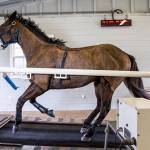Indirect Calorimetry: Determining Energy Source Use in Exercising Horses

Horses consume multiple energy sources, such as starch, fat, and fiber, to fuel growth and performance. These energy sources are often termed “substrates” by nutritionists. By measuring the use of these substrates, researchers can better understand their relevance in nutrition and exercise physiology.
Through the process of indirect calorimetry, substrate utilization by a horse during exercise can be determined by measuring heat production. To measure the amount of heat produced, air inhaled and exhaled by the horse is analyzed for oxygen and carbon dioxide values. By dividing carbon dioxide produced with oxygen consumed, the respiratory exchange ratio (RER) value is calculated to determine what type of substrate is being used by the horse during exercise.
Kentucky Equine Research uses two different types of indirect calorimetry systems. The Versailles, Kentucky, location features an open-circuit indirect calorimeter system. The horse wears a loose-fitting facemask while exercising on the treadmill. This facemask pulls ambient air, along with expired gasses from the horse, through an attached tube down to an oxygen analyzer.
The Ocala, Florida, location has a closed-circuit indirect calorimeter system that measures oxygen on a breath-by-breath basis. Like the open-circuit system, the horse wears a facemask during treadmill exercise. In the closed-circuit system, however, a slim black tube is attached to the side of the mask and connects to an oxygen analyzer. To calibrate the analyzer, a gas tank that contains low amounts of oxygen is used to set the lower standard and atmosphere air is used to set the higher standard.
This closed-circuit facemask, with its snugger fit, reduces the amount of ambient air analyzed with the expired air compared to the open-circuit facemask and is much more portable. To adapt horses to this mask, a dummy mask is used. This dummy mask has the same shape and weight but no attached tube.
Oxygen measurements are generally the same on a breath-by-breath basis but can show variability across a full exercise test. This type of measurement allows nutrition researchers to understand, for example, what type of energy source in feed is more beneficial for certain types of exercise intensities. In the future, this equipment can help researchers better understand the correlation between heart rate and amount of oxygen consumed and produced by a horse during exercise.
This article was written by Ashley Abraham, a University of Florida alumnus and a former intern at Kentucky Equine Research. Learn more about internship opportunities at Kentucky Equine Research.








